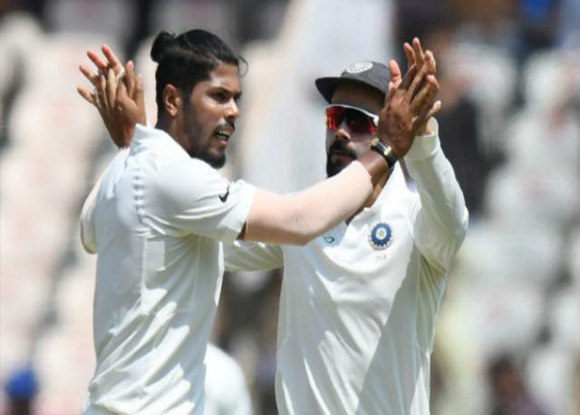
XtraTime Web Desk: Debutant Shardul Thakur picked up an injury on the first day of second test against West Indies fast bowling duties fell squarely on Umesh Yadav’s shoulders, and the 30-year-old responded to the challenge with three key wickets.
Despite losing his partner early in the match, Umesh steamed in tirelessly throughout the first day on a batting-friendly wicket, and was duly rewarded. He was unable to do much with the new ball but made considerable inroads during the brief phases that he got the ball reversing.
It was an even first session in the second Test until Umesh Yadav struck with the last ball before lunch to end Shai Hope’s stay.
India will be the happier team at the break, having the Windies at 86/3.
Umesh’s three wickets were all important ones. He first dismissed a well-set Shai Hope with one that tailed in sharply at the stroke of lunch. His next wicket was that of Shane Dowrich (30), who had also started to look comfortable, while he removed Jason Holder (52) towards the end of the day, which put an end to a fantastic 104-run partnership between the Windies captain and the impressive Roston Chase (98*).
West Indies put in a much improved batting display on the opening day of the second Test in Hyderabad, Roston Chase’s 98* taking the visitors to 295/7 at stumps.
“I didn’t think the ball was swinging too much on that wicket, nor did it reverse as much,” said Umesh. “I think the pitch is quite flat, so it is very important to contain the batsmen, bowl in the same areas. [But] as much as we tried, it was difficult to contain runs. I thought it would become very difficult [for me] if I just looked to contain, so I went for wickets. I had to stay positive.”
Overall, it was a good day for India, but once again their inability to curb lower-order runs came to light. Umesh’s explanation was that the older SG ball offers a lot less for the quicks, which allows batsmen to score far more freely.
Roston Chase is 98 not out at the close of play of day one of the second Test, with Windies 295/7.
Dowrich (30) and Holder (52) also provided useful lower-order contributions.
“I didn’t think the ball was swinging too much on that wicket, nor did it reverse as much,” said Umesh. “I think the pitch is quite flat, so it is very important to contain the batsmen, bowl in the same areas. [But] as much as we tried, it was difficult to contain runs. I thought it would become very difficult [for me] if I just looked to contain, so I went for wickets. I had to stay positive.”
Overall, it was a good day for India, but once again their inability to curb lower-order runs came to light. Umesh’s explanation was that the older SG ball offers a lot less for the quicks, which allows batsmen to score far more freely.
Roston Chase is 98 not out at the close of play of day one of the second Test, with Windies 295/7.
Dowrich (30) and Holder (52) also provided useful lower-order contributions.
“In India when the ball gets old, you neither get pace nor bounce, so then your options become limited. So when the tailenders come, they are well aware that the ball isn’t doing much, so it becomes easier for them. The SG ball goes soft after 20 overs, so when a new batsman comes it isn’t quite as difficult.”
As for Thakur, the prospects of him participating in the remainder of the Test look bleak owing to a groin injury. An India representative said after the match: “He went for scans and we’re awaiting reports, and his condition will be assessed through the day, probably through the next few days. Once we know what his progress is like, his participation will be decided accordingly.”
